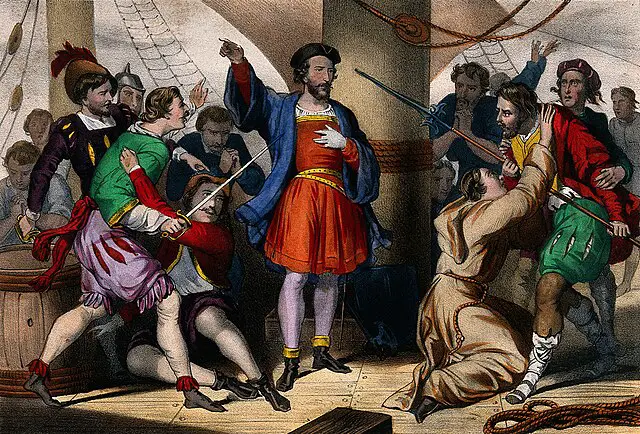The Day the Sky Went Dark: When Columbus Pulled a Cosmic Con
Imagine you’re standing on a beach in Jamaica in 1504. The sun is high. The air is heavy and warm. You’re surrounded by your people, and some strange, desperate Europeans who’ve overstayed their welcome. Then, suddenly, the sun begins to vanish. The world turns cold. Birds fall silent. Everyone panics. And the man with the weird clothes and the big boats tells you he did it.
No, this isn’t the plot of a Netflix historical drama. This actually happened.
And yes, it’s as wild as it sounds.
Out of Supplies and Out of Luck
Christopher Columbus, on his fourth and final voyage to the New World, wasn’t doing so hot. By 1504, he and his crew were stranded in Jamaica. Their ships were basically rotting in the water. Morale was low. The native Taíno people had been generous, but after months of bad behavior and broken promises from the Spaniards, their hospitality dried up.
Food was getting scarce. Columbus had no ships, no supplies, and worst of all, no respect.
But he did have one thing: an almanac.
The Almanac That Changed Everything
Columbus had brought with him an astronomical almanac written by Johannes Müller (also known as Regiomontanus), a German mathematician and astronomer. It contained data about lunar eclipses. And wouldn’t you know it? There was a total lunar eclipse predicted for February 29, 1504.
Columbus saw a golden opportunity. A trick. A scare tactic. Maybe even divine intervention—depending on your perspective.
The Ultimate Bluff
Columbus called a meeting with the local Taíno leaders. He told them, with the full theatrical flair of a desperate man backed into a corner, that his god was angry. Furious, in fact, at the lack of food and kindness shown to his people. And unless the Taíno made things right immediately, the god would show his wrath by turning the moon bloody red.
Now imagine being told this by a pale stranger who sailed in on a giant floating house. You’ve seen some weird stuff since he arrived. He’s gotten sick. He’s yelled at people a lot. But this? This feels different.
Then the eclipse began.
The moon turned dark. Then it turned red.
Panic.
The Taíno, horrified, begged Columbus to restore the moon. To forgive them. To make it stop.
Timing Is Everything
Columbus, milking the moment, dramatically left the scene to “consult” with his god. In reality, he was watching the eclipse through an hourglass. When the eclipse began to wane, he returned and declared that his god had shown mercy. The moon brightened. The world felt right again.
The Taíno brought food. They brought help. The trick worked.
Columbus had just bought himself, and his crew, more time.
A Master Manipulator or Just Lucky?
It’s easy to laugh now, sitting in a world with phone alerts and astronomy apps. But back then? Eclipses were mysterious, terrifying, spiritual events. If you didn’t know what was happening, it was like the universe itself was glitching out.
Columbus didn’t invent this kind of stunt. Earlier cultures used celestial events for political power or religious awe. What makes this story different is that it’s so well documented. And the fact that Columbus used knowledge, science, really, as a tool to manipulate a people who didn’t have access to that same knowledge.
The Moral Mess
Let’s be honest. It’s a great story. Clever. Bizarre. Weirdly satisfying. But it’s also deeply uncomfortable.
This wasn’t just a magician’s trick. It was part of a much bigger, darker story. Columbus’s voyages were brutal for the indigenous people of the Americas. His actions, this eclipse included, were tied to a legacy of colonization, exploitation, and destruction.
So yeah, you can appreciate the cleverness. But it’s worth pausing and asking: At what cost?
Final Thoughts From the Edge of a Shadow
The eclipse stunt of 1504 is one of those rare moments where science, history, drama, and ethics all crash into each other. It’s funny. It’s tragic. It’s impressive. It’s manipulative.
And in the middle of it all was one man with a book, a plan, and a willingness to play god with the moon.
Sources:

